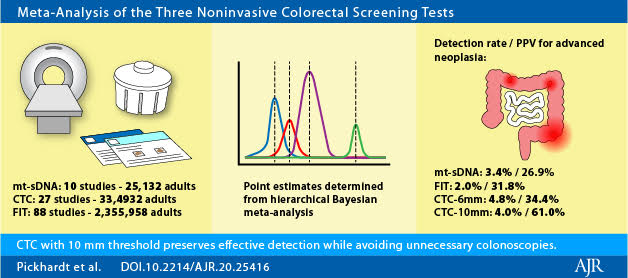For Advanced Neoplasia, CT Colonography is Most Effective Noninvasive Screening Test
 CT colonography (CTC) with ≥ 10 mm threshold most effectively targets advanced neoplasia (AN)—preserving detection while decreasing unnecessary colonoscopies, reports an open access article in the American Journal of Roentgenology (AJR). The researchers compared CTC to multi-target stool-DNA (mt-sDNA) and fecal immunochemical test (FIT).
CT colonography (CTC) with ≥ 10 mm threshold most effectively targets advanced neoplasia (AN)—preserving detection while decreasing unnecessary colonoscopies, reports an open access article in the American Journal of Roentgenology (AJR). The researchers compared CTC to multi-target stool-DNA (mt-sDNA) and fecal immunochemical test (FIT).
Because the relative performance characteristics of available noninvasive tests had not yet been adequately compared, the researchers systematically searched PubMed and Google Scholar, including 10 mt-sDNA, 27 CTC, and 88 FIT published screening studies involving 25,132, 33,4932, and 2,355,958 asymptomatic adults, respectively. To determine test-positivity rates (TPR) leading to optical colonoscopy (OC), as well as positive predictive value (PPV) and detection rate (DR) for both AN and colorectal cancer (CRC), meta-analysis with hierarchical Bayesian modeling was conducted, in accordance with Cochrane Collaboration and PRISMA guidelines.
“CTC performed with a polyp size threshold for colonoscopy referral set at ≥ 10 mm represents the most effective and efficient non-invasive screening test for colorectal cancer prevention and detection,” said first author Perry J. Pickhardt from the department of radiology at the University of Wisconsin School of Medicine & Public Health.
Pickhardt and colleagues’ results showed that CRC prevention via screen detection of AN was highest with CTC, followed by mt-sDNA, and lowest with FIT due to the differing TPR and PPV, although overlap existed in the 95% CIs when accounting for uncertainty. Compared with mt-sDNA and CTC6, FIT and CTC10 strategies yielded substantially lower colonoscopy resource utilization, while mt-sDNA performance appeared to be similar to FIT at low positivity thresholds.
Acknowledging that each CRC screening option has relative advantages and disadvantages that should be carefully considered and tailored to the individual, the authors concluded, “in the end, the ‘best’ test may be the one that the patient is willing to undergo.”